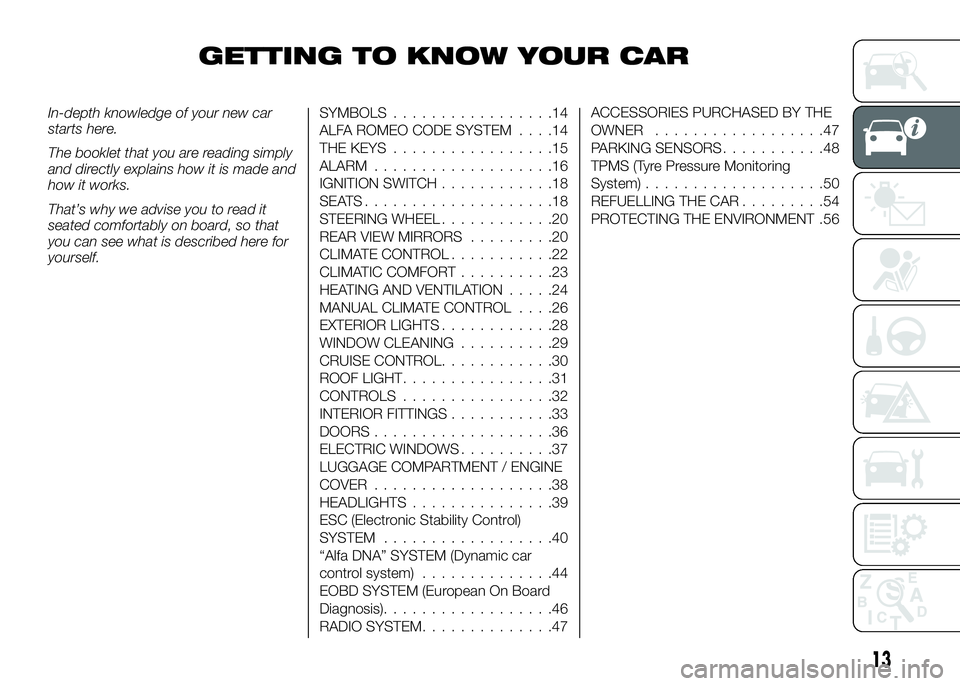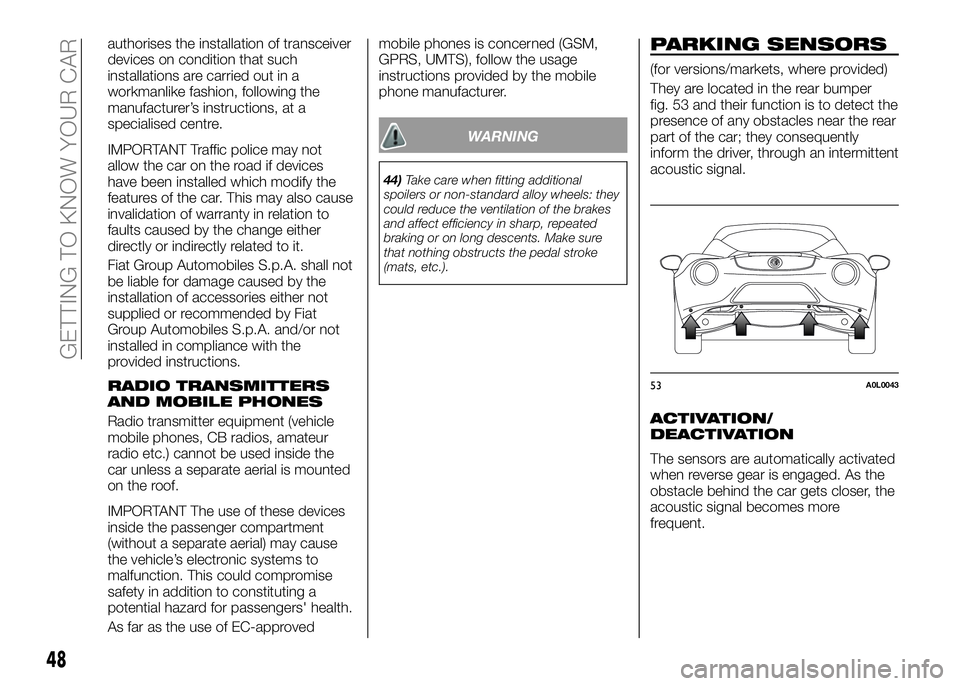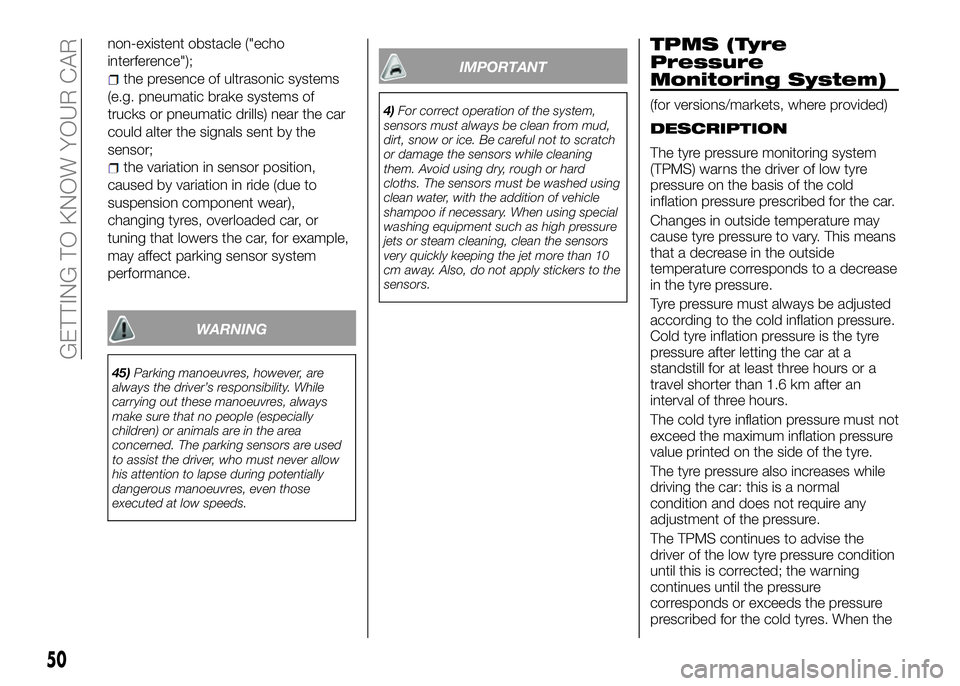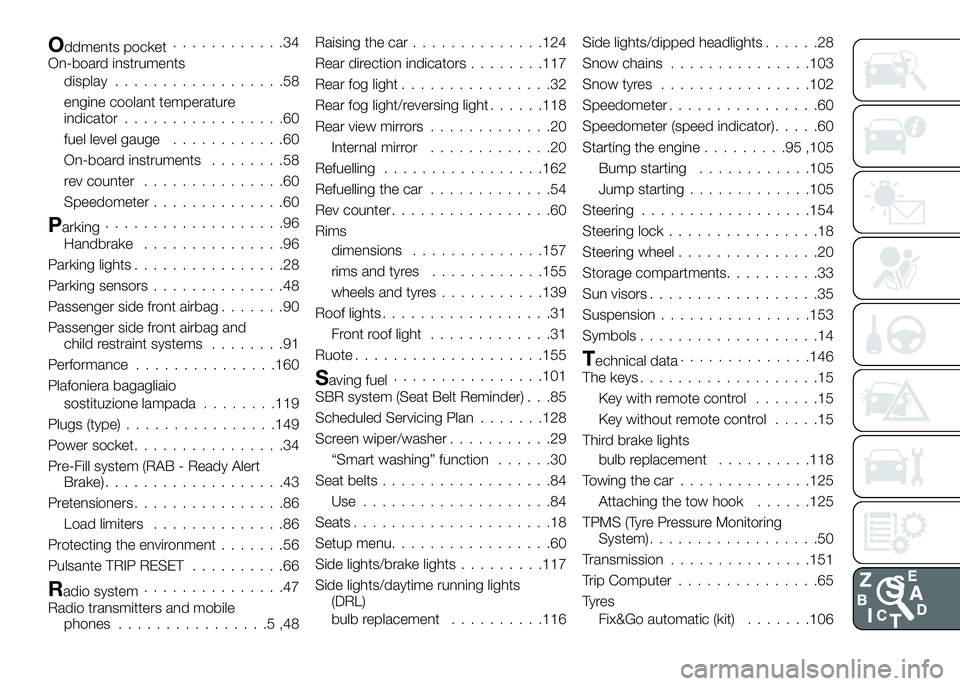parking sensors Alfa Romeo 4C 2016 Owner handbook (in English)
[x] Cancel search | Manufacturer: ALFA ROMEO, Model Year: 2016, Model line: 4C, Model: Alfa Romeo 4C 2016Pages: 182, PDF Size: 9.49 MB
Page 16 of 182

GETTING TO KNOW YOUR CAR
In-depth knowledge of your new car
starts here.
The booklet that you are reading simply
and directly explains how it is made and
how it works.
That’s why we advise you to read it
seated comfortably on board, so that
you can see what is described here for
yourself.SYMBOLS.................14
ALFA ROMEO CODE SYSTEM....14
THE KEYS.................15
ALARM...................16
IGNITION SWITCH............18
SEATS....................18
STEERING WHEEL............20
REAR VIEW MIRRORS.........20
CLIMATE CONTROL...........22
CLIMATIC COMFORT..........23
HEATING AND VENTILATION.....24
MANUAL CLIMATE CONTROL....26
EXTERIOR LIGHTS............28
WINDOW CLEANING..........29
CRUISE CONTROL............30
ROOF LIGHT................31
CONTROLS................32
INTERIOR FITTINGS...........33
DOORS...................36
ELECTRIC WINDOWS..........37
LUGGAGE COMPARTMENT / ENGINE
COVER...................38
HEADLIGHTS...............39
ESC (Electronic Stability Control)
SYSTEM..................40
“Alfa DNA” SYSTEM (Dynamic car
control system)..............44
EOBD SYSTEM (European On Board
Diagnosis)..................46
RADIO SYSTEM..............47ACCESSORIES PURCHASED BY THE
OWNER..................47
PARKING SENSORS...........48
TPMS (Tyre Pressure Monitoring
System)...................50
REFUELLING THE CAR.........54
PROTECTING THE ENVIRONMENT .56
13
Page 51 of 182

authorises the installation of transceiver
devices on condition that such
installations are carried out in a
workmanlike fashion, following the
manufacturer’s instructions, at a
specialised centre.
IMPORTANT Traffic police may not
allow the car on the road if devices
have been installed which modify the
features of the car. This may also cause
invalidation of warranty in relation to
faults caused by the change either
directly or indirectly related to it.
Fiat Group Automobiles S.p.A. shall not
be liable for damage caused by the
installation of accessories either not
supplied or recommended by Fiat
Group Automobiles S.p.A. and/or not
installed in compliance with the
provided instructions.
RADIO TRANSMITTERS
AND MOBILE PHONES
Radio transmitter equipment (vehicle
mobile phones, CB radios, amateur
radio etc.) cannot be used inside the
car unless a separate aerial is mounted
on the roof.
IMPORTANT The use of these devices
inside the passenger compartment
(without a separate aerial) may cause
the vehicle’s electronic systems to
malfunction. This could compromise
safety in addition to constituting a
potential hazard for passengers' health.
As far as the use of EC-approvedmobile phones is concerned (GSM,
GPRS, UMTS), follow the usage
instructions provided by the mobile
phone manufacturer.
WARNING
44)Take care when fitting additional
spoilers or non-standard alloy wheels: they
could reduce the ventilation of the brakes
and affect efficiency in sharp, repeated
braking or on long descents. Make sure
that nothing obstructs the pedal stroke
(mats, etc.).
PARKING SENSORS
(for versions/markets, where provided)
They are located in the rear bumper
fig. 53 and their function is to detect the
presence of any obstacles near the rear
part of the car; they consequently
inform the driver, through an intermittent
acoustic signal.
ACTIVATION/
DEACTIVATION
The sensors are automatically activated
when reverse gear is engaged. As the
obstacle behind the car gets closer, the
acoustic signal becomes more
frequent.
53A0L0043
48
GETTING TO KNOW YOUR CAR
Page 52 of 182

ACOUSTIC SIGNAL
When reverse gear is engaged and
there is an obstacle behind the vehicle,
an acoustic signal is emitted which
varies according to the distance of the
bumper from the obstacle.
The frequency of the acoustic signal:
increases as the distance between
car and obstacle decreases,
culminating in a continuous acoustic
signal, when the distance is less than
approximately 30 cm;
decreases if the distance from the
obstacle increases, until the signal
ceases entirely;
remains constant if the distance
between car and obstacle remains
unchanged; if this situation concerns
the side sensors, the signal will stop
after approximately 3 seconds to avoid,
for example, indications in the event of
manoeuvres along a wall.
If several obstacles are detected by the
sensors, only the nearest one is
considered.
INDICATIONS ON
DISPLAY
(for versions/markets, where provided)
When the sensors are activated, the
screen in fig. 54 appears on the display.Obstacle presence and distance
information is therefore provided both
by the acoustic signal and the
instrument panel display.
The system indicates a detected
obstacle by displaying an arc in one or
more positions according to the
distance of the obstacle and its position
in relation to the car.
If an obstacle is detected in the rear
central area, the display shows all the
arcs in the rear central area, up to the
one that corresponds to the position of
the obstacle itself.
The signal is similar for obstacles in the
rear left or right area.
The arc that corresponds to the
position of the obstacle will flash.
The colour on the display depends on
the distance from and position of the
obstacle.
The car is close to the obstacle when
the display shows a single constant arcand emits a continuous sound.
If there are several obstacles, the
closest one is indicated.
FAULT INDICATION
Parking sensor failures, if any, will be
indicated when reverse is engaged by
the switching on of the
warning
light on the instrument panel together
with the message on the display (see
“Warning lights and messages”
chapter).
GENERAL WARNINGS
45)
4)
When parking, take the utmost care
over obstacles that may be above or
under the sensor.
Under certain circumstances, objects
close to the vehicle are not detected by
the system and could therefore cause
damage to the car or be damaged
themselves.
Some conditions may influence the
performance of the parking sensors:
the presence of ice, snow, mud or
multiple layers of paint on the sensor
surface may cause reduced sensitivity
of the sensor itself and therefore reduce
the system performance;
mechanical interference (e.g.
washing the car, rain, strong wind, hail)
may cause the sensor to detect a
54A0L0044
49
Page 53 of 182

non-existent obstacle ("echo
interference");
the presence of ultrasonic systems
(e.g. pneumatic brake systems of
trucks or pneumatic drills) near the car
could alter the signals sent by the
sensor;
the variation in sensor position,
caused by variation in ride (due to
suspension component wear),
changing tyres, overloaded car, or
tuning that lowers the car, for example,
may affect parking sensor system
performance.
WARNING
45)Parking manoeuvres, however, are
always the driver’s responsibility. While
carrying out these manoeuvres, always
make sure that no people (especially
children) or animals are in the area
concerned. The parking sensors are used
to assist the driver, who must never allow
his attention to lapse during potentially
dangerous manoeuvres, even those
executed at low speeds.
IMPORTANT
4)For correct operation of the system,
sensors must always be clean from mud,
dirt, snow or ice. Be careful not to scratch
or damage the sensors while cleaning
them. Avoid using dry, rough or hard
cloths. The sensors must be washed using
clean water, with the addition of vehicle
shampoo if necessary. When using special
washing equipment such as high pressure
jets or steam cleaning, clean the sensors
very quickly keeping the jet more than 10
cm away. Also, do not apply stickers to the
sensors.
TPMS (Tyre
Pressure
Monitoring System)
(for versions/markets, where provided)
DESCRIPTION
The tyre pressure monitoring system
(TPMS) warns the driver of low tyre
pressure on the basis of the cold
inflation pressure prescribed for the car.
Changes in outside temperature may
cause tyre pressure to vary. This means
that a decrease in the outside
temperature corresponds to a decrease
in the tyre pressure.
Tyre pressure must always be adjusted
according to the cold inflation pressure.
Cold tyre inflation pressure is the tyre
pressure after letting the car at a
standstill for at least three hours or a
travel shorter than 1.6 km after an
interval of three hours.
The cold tyre inflation pressure must not
exceed the maximum inflation pressure
value printed on the side of the tyre.
The tyre pressure also increases while
driving the car: this is a normal
condition and does not require any
adjustment of the pressure.
The TPMS continues to advise the
driver of the low tyre pressure condition
until this is corrected; the warning
continues until the pressure
corresponds or exceeds the pressure
prescribed for the cold tyres. When the
50
GETTING TO KNOW YOUR CAR
Page 180 of 182

Oddments pocket............34
On-board instruments
display..................58
engine coolant temperature
indicator.................60
fuel level gauge............60
On-board instruments........58
rev counter...............60
Speedometer..............60
Parking...................96
Handbrake...............96
Parking lights................28
Parking sensors..............48
Passenger side front airbag.......90
Passenger side front airbag and
child restraint systems........91
Performance...............160
Plafoniera bagagliaio
sostituzione lampada........119
Plugs (type)................149
Power socket................34
Pre-Fill system (RAB - Ready Alert
Brake)...................43
Pretensioners................86
Load limiters..............86
Protecting the environment.......56
Pulsante TRIP RESET..........66
Radio system...............47
Radio transmitters and mobile
phones................5,48Raising the car..............124
Rear direction indicators........117
Rear fog light................32
Rear fog light/reversing light......118
Rear view mirrors.............20
Internal mirror.............20
Refuelling.................162
Refuelling the car.............54
Rev counter.................60
Rims
dimensions..............157
rims and tyres............155
wheels and tyres...........139
Roof lights..................31
Front roof light.............31
Ruote....................155
Saving fuel................101
SBR system (Seat Belt Reminder) . . .85
Scheduled Servicing Plan.......128
Screen wiper/washer...........29
“Smart washing” function......30
Seat belts..................84
Use ....................84
Seats.....................18
Setup menu.................60
Side lights/brake lights.........117
Side lights/daytime running lights
(DRL)
bulb replacement..........116Side lights/dipped headlights......28
Snow chains...............103
Snow tyres................102
Speedometer................60
Speedometer (speed indicator).....60
Starting the engine.........95,105
Bump starting............105
Jump starting.............105
Steering..................154
Steering lock................18
Steering wheel...............20
Storage compartments..........33
Sun visors..................35
Suspension................153
Symbols...................14
Technical data..............146
The keys...................15
Key with remote control.......15
Key without remote control.....15
Third brake lights
bulb replacement..........118
Towing the car..............125
Attaching the tow hook......125
TPMS (Tyre Pressure Monitoring
System)..................50
Transmission...............151
Trip Computer...............65
Ty r e s
Fix&Go automatic (kit).......106